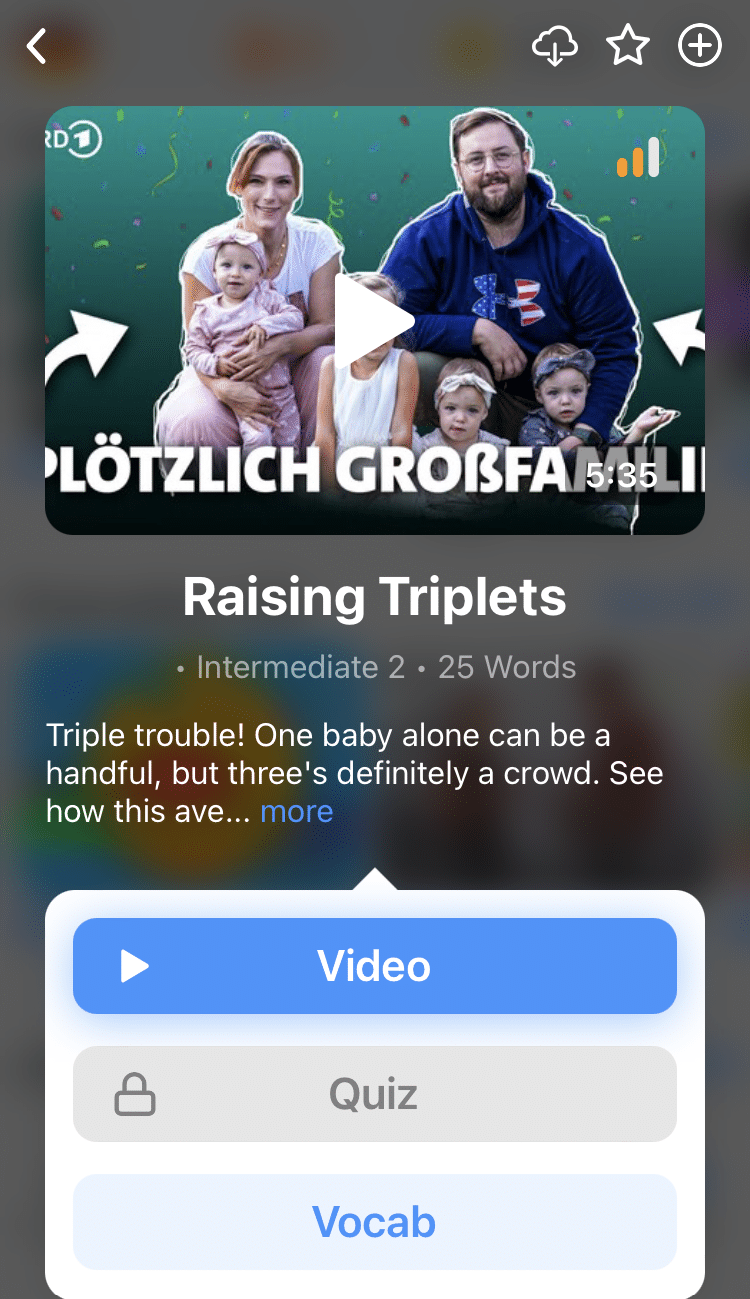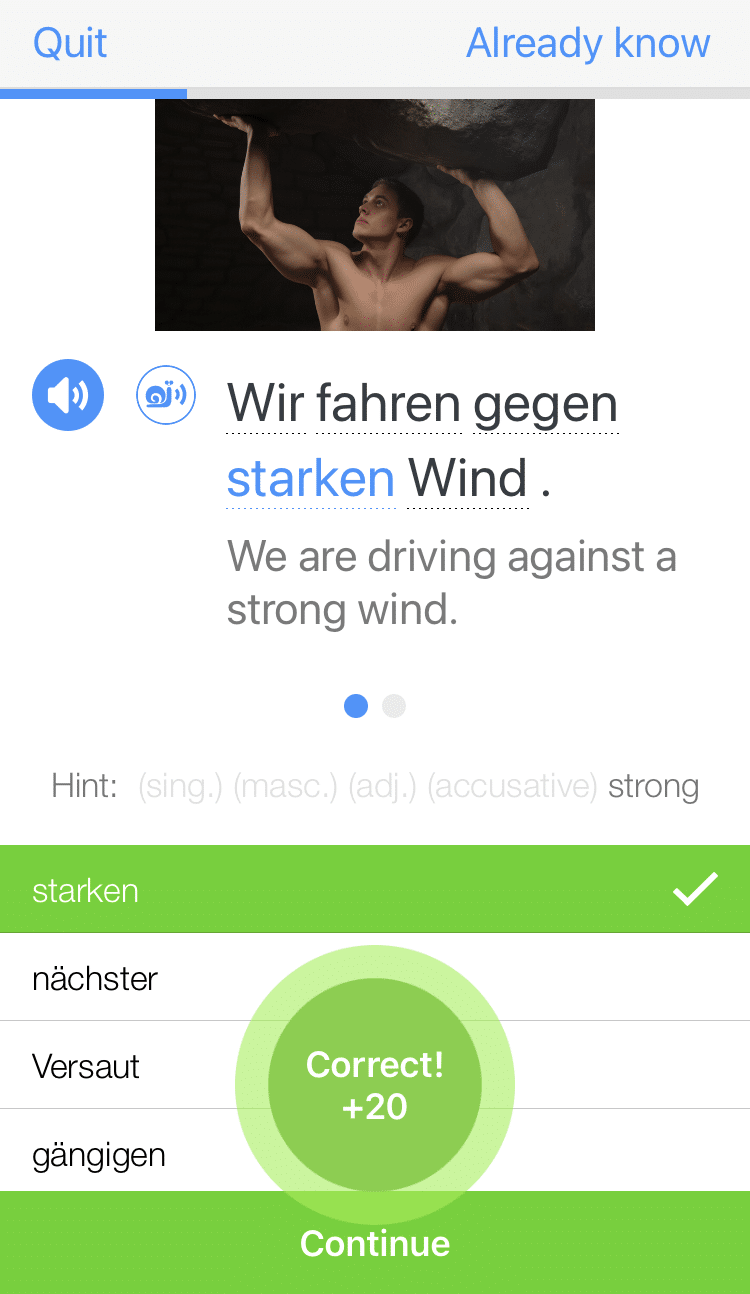
German Pronouns: Complete Guide to the 8 Different Types and How to Use Them Right
Pronouns are an important but tricky component of any language.
Like articles and adjectives, German pronouns change their form depending on a whole host of grammatical factors.
This post will give you everything you need to know about how to form German pronouns and use them correctly, along with plenty of examples, so let’s get started!
Contents
- Why Are German Pronouns Tricky?
- Types of German Pronouns
- Idiomatic German Expressions with Pronouns
- Common Pronoun Mistakes
- And One More Thing...
Download: This blog post is available as a convenient and portable PDF that you can take anywhere. Click here to get a copy. (Download)
Why Are German Pronouns Tricky?
- They change based on case (dative, accusative, nominative). In English, the sentence “That’s her” and “Give it to her” use the same pronoun. To use a German pronoun, you must use context to find the case, then know the proper form in each of those cases.
- German possessive pronouns change based on case—and gender. The word “your” changes based on whether it’s your Katze (cat) or your Handy (mobile phone).
- There’s a difference between independent and dependent possessive pronouns, which changes the ending too. What this means is that pronouns can change depending on whether they comes before a noun or whether they are describing a previously mentioned noun.
Types of German Pronouns
1. Nominative Pronouns
Nominative pronouns are the simplest, most basic pronouns in German, the pronouns that are used as subjects of sentences (I, you, he, she, we and so forth). Here they are:
| Subject | Pronoun |
|---|---|
| I | ich |
| You (informal) | du |
| He | er |
| She | sie |
| It | es |
| We | wir |
| You (plural, informal) | ihr |
| They / You (formal; plural or singular) | sie / Sie |
Examples:
Ich bin hier. (I am here.)
Du gehst nach Hause. (You go home.)
2. Accusative Pronouns
Many sentence constructions call for cases other than nominative. For example, the accusative case is used when the pronoun is the object of the sentence.
Note that several of the accusative pronouns are the same as the nominative pronouns.
The accusative pronouns are:
| Subject | Pronoun |
|---|---|
| I | mich |
| You (informal) | dich |
| He | ihn |
| She | sie |
| It | es |
| We | uns |
| You (plural, informal) | euch |
| They / You (formal; plural or singular) | sie / Sie |
Examples:
Das Getränk ist für dich. (The drink is for you.)
Sie hasst uns. (She hates us.)
3. Dative Pronouns
Dative pronouns are used as the indirect object in a sentence. We use an indirect object when the accusative object is being given or passed onto another person or thing. (eg; You give a present to someone)
You also just need to use the dative as a rule after certain prepositions, eg; mit (with), nach (to), or certain verbs, eg; helfen (to help), folgen (to follow).
And these dative pronouns are:
| Subject | Pronoun |
|---|---|
| I | mir |
| You (informal) | dir |
| He | ihm |
| She | ihr |
| It | ihm |
| We | uns |
| You (plural, informal) | euch |
| They / You (formal; plural or singular) | ihnen / Ihnen |
Examples:
Ich gebe dir den Ball. (I give you the ball.)
Sie geht mit ihnen ins Kino. (She goes to the movies with them.)
Wir helfen euch. (We are helping you [plural].)
4. Genitive Case Pronouns
The genitive case is mostly used as a way of indicating possession, ie: who does something belong to.
| German Nominative Pronoun | Masculine and Neutral Possessive Pronoun | Feminine and Plural Possessive Pronoun |
|---|---|---|
| ich | meines | meiner |
| du | deines | deiner |
| er | seines | seiner |
| sie | ihres | ihrer |
| es | seines | seiner |
| wir | unseres | unserer |
| ihr | eures | eurer |
| sie / Sie | ihres / Ihres | ihrer / Ihrer |
Examples:
Das ist der Hund meines Freundes. (That’s my friend’s dog.)
Das ist das Haus seines Vaters. (That’s his father’s house.)
5. Relative Pronouns
Relative pronouns work like the English “who,” “which,” “what” and “that.”
Relative pronouns are different than most other pronouns because they don’t replace the noun. Rather, they show up later in the sentence and refer back to a noun that was already stated.
For example, in English we could say “it’s the guy who won the race.” The noun is “the guy” but the relative pronoun “who” reminds us what we’re talking about.
Remember not to forget to put the relative pronoun in the correct case. For example, in the sentence:
“What’s the name of the dog that you adopted?”
“The dog” is in the nominative in the first clause but in the accusative in the second, we’d therefore need to translate it like so: Wie heißt der Hund, den du adoptiert hast?
So be sure to keep your wits about you with more tricky examples, like verbs that take the dative case. Like in this example with the verb helfen, which always requires the dative case:
Der Mann, dem du geholfen hast, war sehr dankbar. (The man, whom you helped, was very thankful.)
Also, if you need to use a preposition in the second clause, this needs to come before the relative pronoun, and changes the case accordingly:
Wer war die Frau, mit der du gesprochen hast? (Who was the woman that you were speaking to?)
You can also see relative pronouns take on the genitive case, which shows possession (whose).
Das Kind, dessen Spielzeug er sucht, ist sein Sohn. (The child whose toy he’s looking for, is his son.)
The relative pronouns are:
| Case | Masculine | Neutral | Female | Plural |
|---|---|---|---|---|
| Nominative | der | die | das | die |
| Accusative | den | die | das | die |
| Genitive | dessen | deren | dessen | deren |
| Dative | dem | der | dem | denen |
Examples:
Das ist die Frau, die ich liebe. (That is the woman that I love.)
Kennst du das Mädchen, das sich das Bein gebrochen hat? (Do you know the girl who broke her leg?)
Der Wagen, den er gestern gekauft hat, ist sehr teuer. (The car that he bought yesterday is very expensive.)
6. Dependent Possessive Pronouns
The dependent possessive pronouns are for situations where you want to say that something belongs to you or to someone else. They are “dependent” because they always come before a noun: “That’s my book” or “That’s his car.”
Just like with the personal pronouns, you should start by learning the nominative versions of these German possessive pronouns. Remember, the endings change based on whether the following noun is masculine, feminine, neutral or plural.
Nominative Case
Luckily, in the nominative case, masculine and neutral pronouns follow the same rules, and feminine and plural pronouns follow the same rules.
| German Nominative Pronoun | Masculine and Neutral Possessive Pronoun | Feminine and Plural Possessive Pronoun |
|---|---|---|
| ich | mein | meine |
| du | dein | deine |
| er | sein | seine |
| sie | ihr | ihre |
| es | sein | seine |
| wir | unser | unsere |
| ihr | euer | eure |
| sie / Sie | ihr / Ihr | ihre / Ihre |
Examples:
Wo ist dein Hemd? (Where is your shirt?)
Hier ist unser Haus. (Here is our house.)
Accusative Case
Knowing possessive pronouns in the accusative case is extremely important. You’ll often use the accusative case when talking about your possessions since the verb “to have” takes accusative.
Luckily, they’re all the same as the nominative aside from the masculine ones:
| German Nominative Pronoun | Masculine Possessive Pronoun | Neutral Possessive Pronoun | Feminine and Plural Possessive Pronoun |
|---|---|---|---|
| ich | meinen | mein | meine |
| du | deinen | dein | deine |
| er | seinen | sein | seine |
| sie | ihren | ihr | ihre |
| es | seinen | sein | seine |
| wir | unseren | unser | unsere |
| ihr | eueren | euer | eure |
| sie / Sie | ihren / Ihren | ihr / Ihr | ihre / Ihre |
Examples:
Ich liebe meinen Hund! (I love my dog!)
Haben Sie Ihre Fahrkarte dabei? (Have you got your [formal] ticket with you?)
Dative Case
Like with personal pronouns, dative possessive pronouns deviate further from the nominative base. In dative, masculine and neutral are once again the same, but feminine and plural are different. The pronouns are:
| German Nominative Pronoun | Masculine and Neutral Possessive Pronoun | Feminine Possessive Pronoun | Plural Possessive Pronoun |
|---|---|---|---|
| ich | meinem | meiner | meinen |
| du | deinem | deiner | deinen |
| er | seinem | seiner | seinen |
| sie | ihrem | ihrer | ihren |
| es | seinem | seiner | seinen |
| wir | unserem | unserer | unseren |
| ihr | euerem | eurer | euren |
| sie / Sie | ihrem / Ihrem | ihrer / Ihrer | ihren / Ihren |
Examples:
Wir gehen mit meiner Mutter ins Kino. (We are going to the movies with my mother.)
Gib meinem Mann den Schlüssel. (Give my husband the key.)
FluentU takes authentic videos—like music videos, movie trailers, news and inspiring talks—and turns them into personalized language learning lessons.
You can try FluentU for free for 2 weeks. Check out the website or download the iOS app or Android app.
P.S. Click here to take advantage of our current sale! (Expires at the end of this month.)
7. Independent Possessive Pronouns
Independent possessive pronouns are the equivalent of saying “mine” or “yours” in English. They are “independent” because they are standalone, and do not come before a noun.
Nominative Case
First, we’ll take a look at the nominative case:
| German Nominative Pronoun | Masculine Possessive Pronoun | Neutral Possessive Pronoun | Feminine and Plural Possessive Pronoun |
|---|---|---|---|
| ich | meiner | meins | meine |
| du | deiner | deins | deine |
| er | seiner | seins | seine |
| sie | ihrer | ihres | ihre |
| es | seiner | seins | seine |
| wir | unserer | unseres | unsere |
| ihr | euerer | eures | eure |
| sie / Sie | ihrer / Ihrer | ihres / Ihres | ihre / Ihre |
Examples:
Ist das dein Buch? (Is that your book?)
Ja, das ist meins. (Yes, that is mine.)
Accusative Case
Like the other kinds of pronouns, independent possessive pronouns also decline based on whether they appear in the accusative or dative case.
The pronouns are:
| German Nominative Pronoun | Masculine Possessive Pronoun | Neutral Possessive Pronoun | Feminine and Plural Possessive Pronoun |
|---|---|---|---|
| ich | meinen | meins | meine |
| du | deinen | deins | deine |
| er | seinen | seins | seine |
| sie | ihren | ihres | ihre |
| es | seinen | seins | seine |
| wir | unseren | unseres | unsere |
| ihr | eueren | eures | eure |
| sie / Sie | ihren / Ihren | ihres / Ihres | ihre / Ihre |
Examples:
Hast du meinen Koffer? (Do you have my suitcase?)
Nein, ich habe seinen. (No, I have his.)
Dative Case
The dative independent possessive pronouns are:
| German Nominative Pronoun | Masculine and Neutral Possessive Pronoun | Female Possessive Pronoun | Plural Possessive Pronoun |
|---|---|---|---|
| ich | meinem | meiner | meinen |
| du | deinem | meiner | deinen |
| er | seinem | seiner | seinen |
| sie | ihrem | ihrer | ihren |
| es | seinem | seiner | seinen |
| wir | unserem | unserer | unseren |
| ihr | euerem | eurer | euren |
| sie / Sie | ihrem / Ihrem | ihrer / Ihrer | ihren / Ihren |
Examples:
Fahren wir mit meinem Auto? (Are we taking my car?)
Lieber mit meinem! (I’d prefer to take mine!)
8. Indefinite Pronouns
Indefinite pronouns, also known as unbestimmte Pronomen, are words used to refer to unspecified or unknown people, things or quantities. They can function as subjects, objects or possessive pronouns in a sentence.
Here’s a list of some common German indefinite pronouns:
- etwas (something)
- jemand (someone)
- niemand (nobody)
- alle (everyone)
- keiner (nobody/none)
- ein paar (a few)
- viele (many)
- wenige (few)
- manche (some)
- andere (others)
- mehrere (several)
- kein (none/not any)
- jeder (everyone)
- irgendein (some/any)
- beide (both)
For an example, let’s take a look at the different forms of the indefinite pronoun kein (none/not any):
| Case | Masculine | Feminine | Neuter | Plural |
|---|---|---|---|---|
| Nominative | kein | keine | kein | keine |
| Accusative | keinen | keine | kein | keine |
| Dative | keinem | keiner | keinem | keinen |
| Genitive | keines | keiner | keines | keiner |
Nominative case
Examples:
Ich habe keine Katze. (I don’t have a cat.)
Er ist kein Arzt. (He is not a doctor.)
Sie ist keine Lehrerin. (She is not a teacher.)
Accusative case
Examples:
Ich habe keinen Hund. (I don’t have a dog.)
Sie hat keine Katze. (She doesn’t have a cat.)
Er hat kein Auto. (He doesn’t have a car.)
Dative case
Examples:
Ich gebe keinem Mann das Buch. (I’m not giving the book to any man.)
Sie hilft keiner Frau. (She’s not helping any woman.)
Er gibt keinem Kind Süßigkeiten. (He’s not giving sweets to any child.)
Genitive case
Examples:
Ich habe keines Mannes Adresse. (I don’t have any man’s address.)
Er kennt keines Kindes Eltern. (He doesn’t know any child’s parents.)
Idiomatic German Expressions with Pronouns
Jemandem auf den Zahn fühlen.
Literal translation: “To feel someone on the tooth.”
Meaning: To question someone closely, to get to the bottom of something.
Die Nase voll haben.
Literal translation: “To have the nose full.”
Meaning: To be fed up or to have had enough.
Sich in die Nesseln setzen.
Literal translation: “To sit in the nettles oneself.”
Meaning: To get oneself into trouble.
Das ist nicht mein Bier.
Literal translation: “That’s not my beer.”
Meaning: That’s not my problem or concern.
Seinen Senf dazugeben.
Literal translation: “To add one’s mustard.”
Meaning: To give one’s opinion, often when it’s not asked for.
Das ist nicht mein Ding.
Literal translation: “That’s not my thing.”
Meaning: That’s not my area of expertise or interest.
Jemandem Honig um den Mund schmieren.
Literal translation: “To smear honey around someone’s mouth.”
Meaning: To flatter someone.
Tomaten auf den Augen haben.
Literal translation: “To have tomatoes on one’s eyes.”
Meaning: To be oblivious or not see something that’s obvious to others.
Auf Nummer sicher gehen.
Literal translation: “To go on number sure.”
Meaning: To play it safe or take precautions.
Sich ins Fäustchen lachen.
Literal translation: “To laugh into one’s little fist.”
Meaning: To chuckle quietly to oneself.
Common Pronoun Mistakes
- Confusing Accusative and Dative Pronouns
Accusative and dative pronouns can be tricky for learners because they often correspond to different English pronouns. Mixing them up can lead to incorrect sentence structure.
- Misusing Reflexive Pronouns
Reflexive pronouns (such as sich) are used to indicate that the subject of a sentence is also the object. Some learners struggle with when and how to use reflexive pronouns correctly.
- Forgetting Gender and Case Agreement
German pronouns must agree with the gender and case of the noun they replace. Failing to match them correctly can result in grammatical errors.
- Confusing Formal and Informal Pronouns
German has both formal and informal pronoun forms for addressing others (for example, Sie vs. du). Using the wrong form can lead to misunderstandings or come across as impolite.
- Neglecting Possessive Pronouns
Learners sometimes forget to use possessive pronouns (for example, mein, dein, sein) when indicating ownership. This can lead to confusion about who the subject is referring to.
- Overusing Pronoun es
Learners sometimes rely too heavily on the pronoun es (it) as a placeholder, even when there are more specific pronouns or nouns that could be used.
- Translating Directly from English
Trying to directly translate English pronouns to German can lead to mistakes, as the two languages often use different pronoun forms and have different rules for their usage.
- Forgetting the Genitive Case Pronouns
The genitive case pronouns (meines, deines, seines, etc.) are less commonly used in modern German, but learners may still encounter them and sometimes forget their forms.
- Neglecting Pronoun Placement in Relative Clauses
The placement of pronouns in relative clauses can be challenging. Learners need to remember to place them in the correct position within the sentence.
Now that you know the different types of German pronouns and what they are, you can talk about yours, mine and ours and sound even more fluent!
Download: This blog post is available as a convenient and portable PDF that you can take anywhere. Click here to get a copy. (Download)
And One More Thing...
Want to know the key to learning German effectively?
It's using the right content and tools, like FluentU has to offer! Browse hundreds of videos, take endless quizzes and master the German language faster than you've ever imagine!
Watching a fun video, but having trouble understanding it? FluentU brings native videos within reach with interactive subtitles.
You can tap on any word to look it up instantly. Every definition has examples that have been written to help you understand how the word is used. If you see an interesting word you don't know, you can add it to a vocabulary list.
And FluentU isn't just for watching videos. It's a complete platform for learning. It's designed to effectively teach you all the vocabulary from any video. Swipe left or right to see more examples of the word you're on.
The best part is that FluentU keeps track of the vocabulary that you're learning, and gives you extra practice with difficult words. It'll even remind you when it’s time to review what you’ve learned.
Start using the FluentU website on your computer or tablet or, better yet, download the FluentU app from the iTunes or Google Play store. Click here to take advantage of our current sale! (Expires at the end of this month.)







